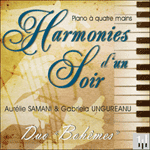‘In this repertoire Lewis and Osborne are as one, touch and tone indistinguishable from one another (they swap Primo and Secondo roles throughout, apparently, though it’s impossible to tell who is playing which in what), playing with a delicious fluency and obvious affection that is a joy to hear. They open with the Allegro in A minor in a finely graded and characterised reading that puts Jenő Jandó and Illona Prunyi (12/92), for example, in the shade. To conclude, there is the great F minor Fantasie in which the incomparable opening is leant a hint of optimism, even jauntiness, before the subsequent journey to a pathetic conclusion. This is a reading that compares favourably with the benchmark recording by Radu Lupu and Murray Perahia (3/86) … this is a Schubert disc to return to and live with’ (Gramophone)
‘Engaged and often exquisite music-making … such playing suggests they have found the key to conveying Schubert's magical world of shadows and sunlight’ (BBC Music Magazine)
‘For those who were fortunate enough to be there, and just as importantly for those who missed it, this disc captures all the exuberance, finesse and camaraderie with which Steven Osborne and Paul Lewis gave their recital of Schubert duets at London’s Wigmore Hall in January. Shortly afterwards they went into the studios to record the same six works, and the result is a pure delight … the quality that shines through in these performances is the way in which Schubert so intuitively judged the special medium of the piano duet. The music is specifically imagined with four hands in mind, at times taxing from the point of view of the two pianists amicably accommodating and coordinating with one another but always with the sense that the potential for varied sonority, expressive breadth and, without doubt, a degree of fun is being broadly and knowledgeably exploited. The F minor Fantasie enshrines some of Schubert’s most sublime ideas, but his range throughout embraces vigour, subtlety, daring, charm, delicacy and drama. Osborne and Lewis have full measure of its inventive scope on a disc of outstanding, enlivening musicianship’ (The Daily Telegraph)
‘From the opening thunderclap of the 'Lebensstürme' it is clear that great things are in store. As furiously impassioned a movement as Schubert ever wrote, the piece poses some of the thorniest ensemble challenges to be found among the duet works … Lewis and Osborne meet these demands with one heart and one mind and do so, moreover, with an audacity that doesn't sacrifice a single degree of the work's molten intensity … no one with a taste for superlative, passionately committed music-making, ensemble of the highest calibre or some of Schubert's most beautiful music can afford to miss this one’ (International Record Review)
‘The Fantasie in F minor would earn its place in any list of Schubert's supreme masterpieces. Osborne and Lewis predictably reserve their finest, most perceptive playing for the Fantasie, giving its infinitely regretful main theme a different shading on each of its appearances and colouring the work's harmonic shifts and modulations impeccably. None of their performances could be described as routine, though, even when the music is less than top drawer, and in works such as the A flat major Variations and the deceptively modest-sounding Allegro in A minor, both of which approach the Fantasie in scale, they find emotional depths and dramas that unmistakably identify both as products of Schubert's final year’ (The Guardian)

‘This brilliantly planned programme is executed with poetry, drama and verve by two complementary pianists who clearly think as one in this sublime chamber music’ (The Sunday Times)
‘Osborne and Lewis fly with Schubertian grace through some of the most inspired music every conceived for piano duet’ (The Irish Times)
‘This is a recording which, quite simply, deserves immediate ‘classic’ status, and will be high on anyone’s wanted list of Schubert piano releases for a very long time indeed. Challengers such as the DOM label’s Irena Kofman and André de Groote and the more completist bargain EMI sets with Christoph Eschenbach and Justus Frantz have their qualities, but this Hyperion release is much more of an all-round winner’ (MusicWeb International)
‘There’s plenty of intimacy here, but also a satisfying expansiveness too—the Allegro in A minor thunders into vivid life here, relaxing magically when the gentle second subject comes into view, decorated beautifully by the second pianist. Who plays what part is not made clear; the notes tell us that Lewis and Osborne alternate the first and second roles. The short Fugue in E minor, composed in a few hours, is carefully voiced, reaching a magnificent, sonorous climax. Best of all is the Fantasie in F minor, and the ease with which Lewis and Osborne match the hesitant, melancholy opening theme with its more flowing accompaniment’ (TheArtsDesk.com)



 Harmonies d'un Soir
Harmonies d'un Soir
